
A starburst galaxy is one undergoing an exceptionally high rate of star formation, as compared to the long-term average rate of star formation in the galaxy or the star formation rate observed in most other galaxies. For example, the star formation rate of the Milky Way galaxy is approximately 3 M☉/yr, while starburst galaxies can experience star formation rates of 100 M☉/yr or more. In a starburst galaxy, the rate of star formation is so large that the galaxy will consume all of its gas reservoir, from which the stars are forming, on a timescale much shorter than the age of the galaxy. As such, the starburst nature of a galaxy is a phase, and one that typically occupies a brief period of a galaxy's evolution. The majority of starburst galaxies are in the midst of a merger or close encounter with another galaxy. Starburst galaxies include M82, NGC 4038/NGC 4039, and IC 10.

NGC 6946, sometimes referred to as the Fireworks Galaxy, is a face-on intermediate spiral galaxy with a small bright nucleus, whose location in the sky straddles the boundary between the northern constellations of Cepheus and Cygnus. Its distance from Earth is about 25.2 million light-years or 7.72 megaparsecs, similar to the distance of M101 in the constellation Ursa Major. Both were once considered to be part of the Local Group, but are now known to be among the dozen bright spiral galaxies near the Milky Way but beyond the confines of the Local Group. NGC 6946 lies within the Virgo Supercluster.

NGC 1232 is an intermediate spiral galaxy about 60 million light-years away in the constellation Eridanus. It was discovered by German-British astronomer William Herschel on 20 October 1784.
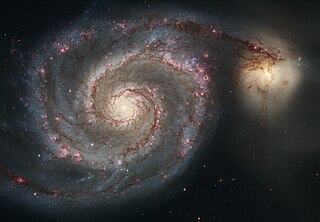
The Multiwavelength Atlas of Galaxies is a textbook and atlas of 35 well studied galaxies authored by Glen Mackie of the Centre for Astrophysics & Supercomputing, Swinburne University of Technology. It was originally published in 2011 by Cambridge University Press.
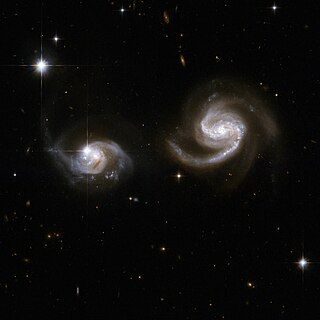
NGC 6786 is an interacting spiral galaxy 350 million light years from the Earth, in the constellation of Draco. NGC 6786 is currently interacting with LEDA 62867, and, being the larger galaxy, it is likely that NGC 6786 will absorb LEDA 62867 in the future. Both galaxies appear to be undergoing a starburst, a phenomenon commonly seen among interacting and merging galaxies.
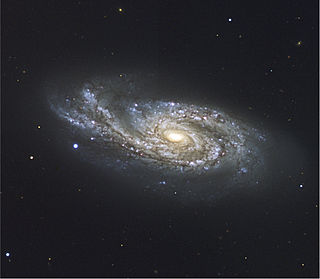
NGC 908 is an unbarred spiral galaxy in the constellation Cetus. It was discovered in 1786 by William Herschel. This galaxy is 56 million light years away from Earth. It is the main galaxy in the NGC 908 group, which also includes NGC 899, NGC 907, and IC 223.

NGC 4762 is an edge-on lenticular galaxy in the constellation Virgo. It is at a distance of 60 million light years and is a member of the Virgo Cluster. The edge-on view of this particular galaxy, originally considered to be a barred spiral galaxy, makes it difficult to determine its true shape, but it is considered that the galaxy consists of four main components — a central bulge, a bar, a thick disc and an outer ring. The galaxy's disc is asymmetric and warped, which could be explained by NGC 4762 merging with a smaller galaxy in the past. The remains of this former companion may then have settled within NGC 4762's disc, redistributing the gas and stars and so changing the disc's morphology.

NGC 1614 is the New General Catalogue identifier for a spiral galaxy in the equatorial constellation of Eridanus. It was discovered on December 29, 1885 by American astronomer Lewis Swift, who described it in a shorthand notation as: pretty faint, small, round, a little brighter middle. The nebula was then catalogued by Danish-Irish astronomer J. L. E. Drayer in 1888. When direct photography became available, it was noted that this galaxy displayed some conspicuous peculiarities. American astronomer Halton Arp included it in his 1966 Atlas of Peculiar Galaxies. In 1971, Swiss astronomer Fritz Zwicky described it as a "blue post-eruptive galaxy, compact patchy core, spiral plumes, long blue jet SSW".
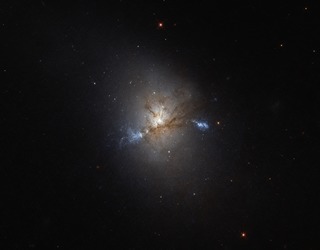
NGC 1222 is an early-type lenticular galaxy located in the constellation of Eridanus. The galaxy was discovered on 5 December 1883 by the French astronomer Édouard Stephan. John Louis Emil Dreyer, the compiler of the New General Catalogue, described it as a "pretty faint, small, round nebula" and noted the presence of a "very faint star" superposed on the galaxy.

NGC 1140 is an irregular galaxy in the southern constellation of Eridanus. Estimates made using the Tully–Fisher method put the galaxy at about 59 million light years. It was discovered on 22 November 1786 by William Herschel, and was described as "pretty bright, small, round, stellar" by John Louis Emil Dreyer, the compiler of the New General Catalogue.

NGC 4491 is a dwarf barred spiral galaxy located about 55 million light-years away in the constellation Virgo. NGC 4491 was discovered by astronomer William Herschel on March 15, 1784. NGC 4491 is located in a subgroup of the Virgo Cluster centered on Messier 87 known as the Virgo A subgroup.

NGC 6810 is a spiral galaxy approximately 87 million light-years away from Earth in the constellation of Pavo.

NGC 5774 is an intermediate spiral galaxy approximately 71 million light-years away from Earth in the constellation of Virgo. It was discovered by Irish engineer Bindon Stoney on April 26, 1851.

NGC 6045 is a barred spiral galaxy located about 450 million light-years away in the constellation Hercules. NGC 6045 was discovered by astronomer Lewis Swift on June 27, 1886 and is a member of the Hercules Cluster. It is also a LINER galaxy.
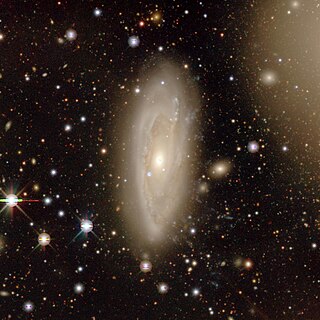
NGC 3312 is a large and highly inclined spiral galaxy located about 194 million light-years away in the constellation Hydra. The galaxy was discovered by astronomer John Herschel on March 26, 1835. It was later rediscovered by astronomer Guillaume Bigourdan on February 26, 1887. NGC 3312 was later listed and equated with IC 629 because the two objects share essentially the same celestial coordinates. NGC 3312 is the largest spiral galaxy in the Hydra Cluster and is also classified as a LINER galaxy.

NGC 3859 is a spiral galaxy located about 295 million light-years away in the constellation Leo. It was discovered by astronomer Édouard Stephan on March 23, 1884. The galaxy is a member of the Leo Cluster.
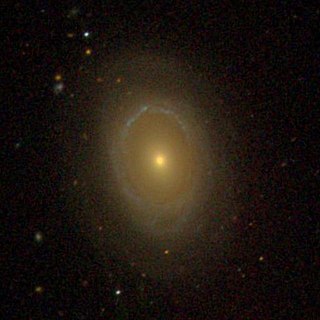
NGC 3884 is a spiral galaxy located about 330 million light-years away in the constellation Leo. The galaxy was discovered by astronomer William Herschel on April 27, 1785 and is a member of the Leo Cluster.

NGC 703 is a lenticular galaxy located 240 million light-years away in the constellation Andromeda. The galaxy was discovered by astronomer William Herschel on September 21, 1786 and is also a member of Abell 262.
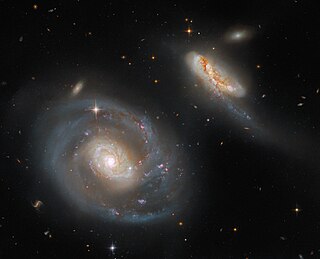
NGC 7469 is an intermediate spiral galaxy in the constellation of Pegasus. NGC 7469 is located about 200 million light-years away from Earth, which means, given its apparent dimensions, that NGC 7469 is approximately 90,000 light-years across. It was discovered by William Herschel on November 12, 1784.

NGC 541 is a lenticular galaxy located in the constellation Cetus. It is located at a distance of circa 230 million light years from Earth, which, given its apparent dimensions, means that NGC 541 is about 130,000 light years across. It was discovered by Heinrich d'Arrest on October 30, 1864. It is a member of the Abell 194 galaxy cluster and is included in the Atlas of Peculiar Galaxies in the category galaxies with nearby fragments. NGC 541 is a radio galaxy of Fanaroff–Riley class I, also known as 3C 40A.




















